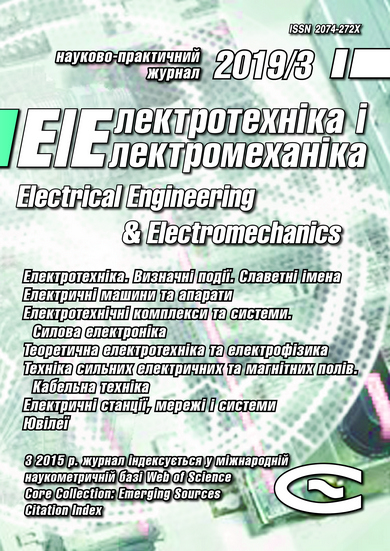REFINED SELECTION OF ALLOWABLE CROSS-SECTIONS OF ELECTRICAL CONDUCTORS AND CABLES IN THE POWER CIRCUITS OF INDUSTRIAL ELECTRICAL EQUIPMENT TAKING INTO ACCOUNT EMERGENCY OPERATING MODES
DOI:
https://doi.org/10.20998/2074-272X.2019.3.06Keywords:
electric power engineering, electric wires and cables of circuits of electrical installations of the general industrial purpose, calculation selection of allowable sections of wires and cables in the circuits of electrical equipmentAbstract
Purpose. Implementation and clarification of the existing engineering approach for determination in industrial power engineering for allowable sections of cable-conductor products (CCP) Sil of electric wires and cables in the circuits of electrical equipment of the general industrial installations characterized flowing in malfunction of current ik(t) of short circuit (SC) with different amplitude-temporal parameters (ATPs). Methodology. Scientific and technical bases of electrical power engineering, electrophysics bases of technique of high voltage and high pulse currents, theoretical bases of the electrical engineering. Results. The results of the developed engineering approach are resulted in the calculation determination on the condition of thermal resistibility of CCP permissible sections of Sil of the uninsulated wires, insulated wires and cables with copper (aluminum) cores (shells), polyvinyl chloride (PVC), rubber (R) and polyethylene (PET) insulation, on which in malfunction of their operation the current ik(t) of SC can flow with the set by normative documents of ATP. It is shown that divergence between the values of basic calculation coefficient of Cik by existing and offered to the engineering calculations selection of permissible sections of Sil of cores (shells) of the tested wires and cables for normal of their operating time at the nominal current load of CCP makes no more (3-8) %, and in the mode of de-energizing of CCP arrives at to (9-26) %.. Analytical correlation is got for the specified calculation determination of integral of action of Jak of current ik(t) of SC (Joule integral) in the power circuits of the tested electrical equipment. It is set that in the circuits of of the general industrial installations (for permanent time of slump of Ta=20 ms of aperiodic constituent of current of SC) maximum possible amplitudes of density of δilm≈Imk/Sil of SC current at time of his disconnecting tkC=100 ms for the uninsulated wires with copper (aluminum) cores make according to approximately 0.64 (0.36) кА/mm2, for cables with copper (aluminum) cores (shells), PVC and R insulation – 0.47 (0.30) кА/mm2, and for cables with copper (aluminum) cores ( shells) and PET insulation – 0.39 (0.25) кА/mm2. At time of disconnecting tkC=160 ms of SC current in the circuits of electrical equipment (Ta=20 ms) permissible amplitudes of current density of δilm of SC for the unsuolated wires with copper and aluminum cores are accordingly about 0.52 (0.29) кА/mm2, for cables with copper (aluminum) cores (shells), PVC and R insulation of 0.39 (0.25) кА/mm2, and for cables with copper (aluminum) cores (shells) and PET insulation – 0.32 (0.21) кА/mm2. Originality. First by a calculation the specified numeral values of sections of Sil and amplitudes of density δilm of SC current are determined for the uninsulated wires, insulated wires and cables with copper (aluminum)cores shells), PVC, R and PET insulation. New analytical correlation is offered for the calculation estimation of thermal resistibility of tested CCP to the action of current of SC. Practical value. The obtained results will be useful in the increase of thermal resistibility of CCP with copper (aluminum) cores (shells), PVC, R and PET insulation, widely applied in the power circuits of electrical equipment of the general purpose industrial installations.References
Orlov I.N. Elektrotehnicheskij spravochnik. Proizvodstvo i raspredelenie elektricheskoj energii. Tom 3, Kn. 1 [Electrical engineering handbook. Production and distribution of electric energy. Vol. 3, Book 1. Ed. I.N. Orlov]. Moscow, Energoatomizdat Publ., 1988. 880 p. (Rus).
Barybin Yu.G. Spravochnik po proektirovaniyu elekricheskih setey i oborudovanija [Handbook per planning electrical circuit and equipment]. Moscow, Energoatomizdat Publ., 1991. 464 p. (Rus).
Knyazevskyi B.A., Lipkin B.Yu. Elekrosnabzhenie promyschlennyh predpriyatij [Electric supply industrial organization]. Moscow, High school Publ., 1972. 432 p. (Rus).
Belorussov N.I., Saakjan A.E., Jakovleva A.I. Elektricheskie kabeli, provoda i shnury. Spravochnik [Electrical cables, wires and cords. Directory]. Moscow, Energoatomizdat Publ., 1988. 536 p. (Rus).
Knopfel' G. Sverkhsil'nye impul'snye magnitnye polia [Ultra strong pulsed magnetic fields]. Moscow, Mir Publ., 1972. 391 p. (Rus).
Baranov M.I. Izbrannye voprosy elektrofiziki. Monografiya v 3 tomah. Tom 3: Teorija i praktika elektrofizicheskih zadach [Selected topics of Electrophysics. Monograph in 3 vols. Vol. 3: Theory and practice of electrophysics tasks]. Kharkiv, Tochka Publ., 2014. 400 p. (Rus).
Downloads
Published
How to Cite
Issue
Section
License
Copyright (c) 2019 M. I. Baranov

This work is licensed under a Creative Commons Attribution-NonCommercial 4.0 International License.
Authors who publish with this journal agree to the following terms:
1. Authors retain copyright and grant the journal right of first publication with the work simultaneously licensed under a Creative Commons Attribution License that allows others to share the work with an acknowledgement of the work's authorship and initial publication in this journal.
2. Authors are able to enter into separate, additional contractual arrangements for the non-exclusive distribution of the journal's published version of the work (e.g., post it to an institutional repository or publish it in a book), with an acknowledgement of its initial publication in this journal.
3. Authors are permitted and encouraged to post their work online (e.g., in institutional repositories or on their website) prior to and during the submission process, as it can lead to productive exchanges, as well as earlier and greater citation of published work.





